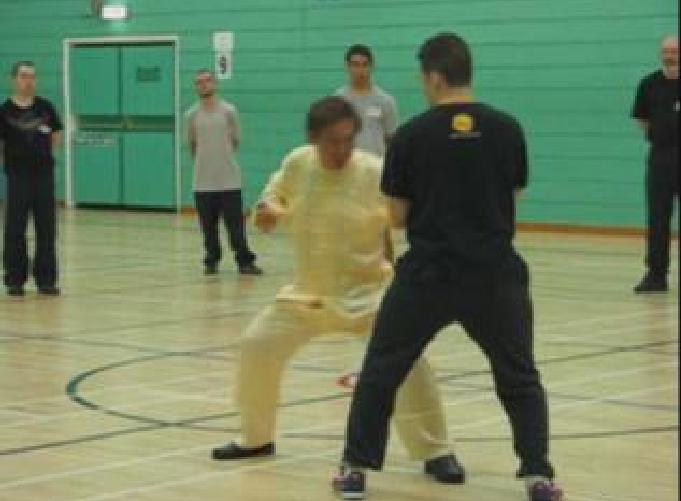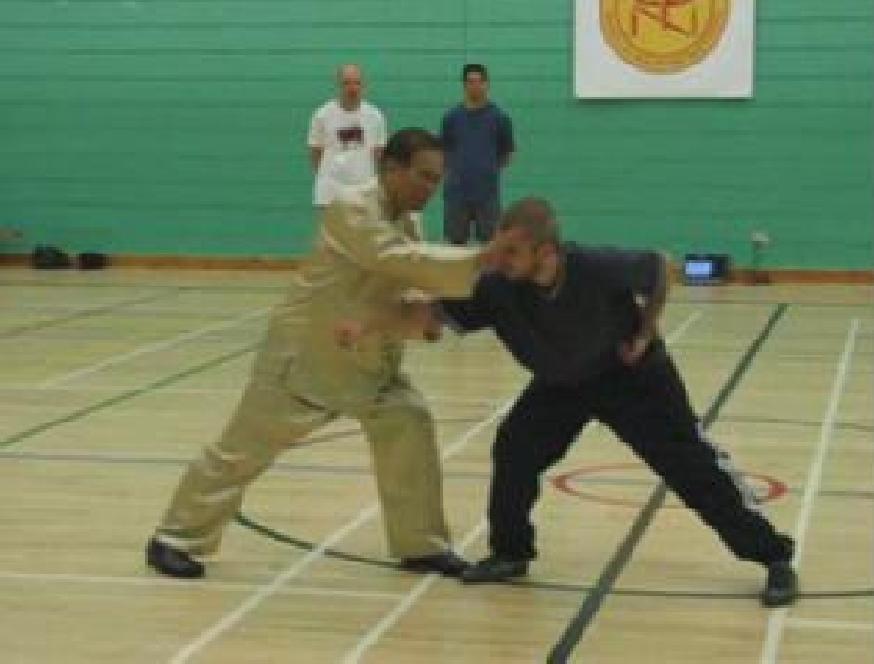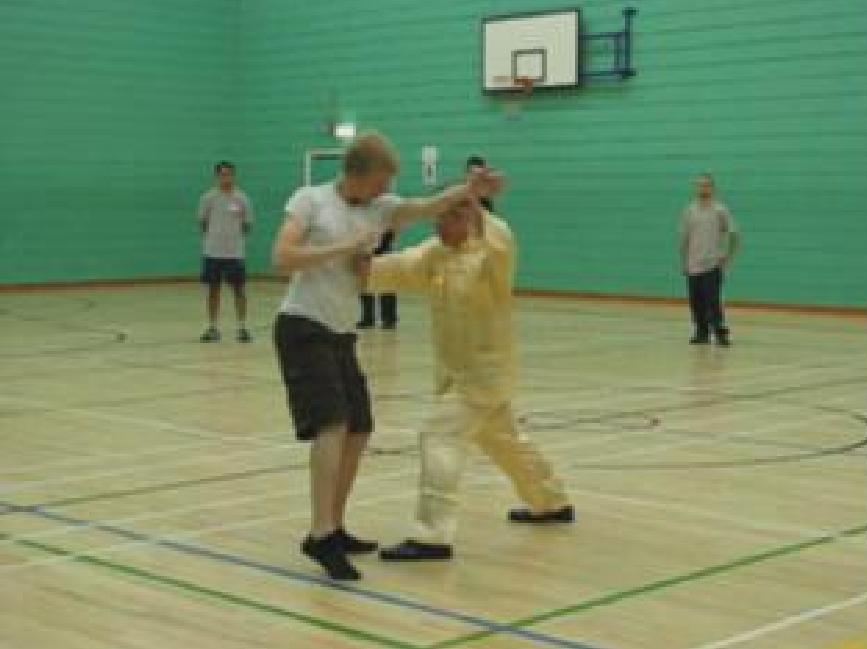NOVEMBER 2009 (Part 2)
SELECTION OF QUESTIONS AND ANSWERS

Participants at a regional chi kung course in Portugal practicing non-thought during Standing Zen
Question 1
Are there any other major considerations in flowing attacks?
— Sifu Jonny Say, Scotland
Answer
It is very important to cover your opponent adequately so that in your zest to attack your opponent, you wouldn't be struck by him instead.
"Safety First" is the first rule of effective combat. This is in contrast with many matial artists today, whose guideline seems to be "Win at All Cost". It is unthinkable that many of them attackwithout any regard of their own safety.
Another important consideration is to flow smoothly. You may vary your speed accordingly, but the flow irrespective of its speed must be smooth.
As we sometimes purposely slow down our speed, it is obvious that just being fast is not necessarily an advantage always. Sometimes being too fast can be a disadvantage.
Question 2
Relating to the use of internal force I have heard you mention we can use internal force like an electric current or like a hose pipe. Could you clarify these two approaches?
Answer
It is a common mis-conception, even among some advanced practitioners, that internal force is necessarily soft. Just as exteranl force can be soft, internal force can also be very hard. Wing Choon and Aikido are examples of external arts that are soft. Hsing Yi Kungfu is a good example of a hard, internal martial art.
"Hard" and "soft" here, which are poor translations of "gang" and "rou" in Chinese, are different from what many Westerners regard as hard and soft. "Soft" here can be very powerful.
An empty hose is limp. We can make it taut by lining its interior with strong iron wires. This is a rough analogy of a person's arm made taut by tensing his muscles. If we support the hose and chop it with an axe, we may break it into two.
Instead of using strong iron wires to make the hose taut, we may do so by filling it with running water. This is a rough analogy of a person's arm made taut by powerful flowing energy. If we support the hose and chop it with an axe, the axe would be bounced away. This water hose full of running water is a good illustration of hard internal force. If we smash the hose onto some bricks, it can easily break the bricks.
Now we have a live wire connected to a power point. When we switch on the power, it examplies soft internal force. If we hit the wire onto some bricks we cannot break the bricks even when the power is on. But if we connect it to an opponent, we can cause tremendous damage.

Covering an opponent adequately before attacking him is very important in combat if you do not wish to be hit randonly
Question 3
In the story you tell us when you received the gentle tap which put you out of action for many months, was this using the electric wire method? I was intrigued because you said at the time you felt fine but later you felt ill. In fighting can this type of force be used to manifest instant results or does it always have delayed response?
Answer
Yes, the "gentle" touch from my siheng was an example of the electric wire method. Had he not pulled back immediately, or had he hit with an intention to hurt, the damage would be many times more serious. Although such kungfu feats were recorded, many martial artists today may not believe that we still have such arts. I am glad that I had this personal experience to confirm the existence of such feats, though it was not pleasant and certainly I would not want to experience it again.
I felt perfectly fine at the time of being struck, or more correctly being gently tapped. There was not the slightest pain at all, and there was also no external sign. The ill feeling came two days later.
Yes, this type of force can be used to manifest instant result. Some of your sipaks and sikumas, like Anthony Korahais and Riccardo Puleo, saw an example many years ago during an Intensive Taijiquan Course. One of the participants, a huge-sized Karate master from Russia, was being rough to other participants, despite me having told him to be more gentle. The last strall was when he intentionally hit Laura Ferandez, our instructor from Spain. I told him that we were doing Pushing Hands, not free sparring.
He asked me, through an interpreter whom he brought along to the course, whether Taijiquan could be used for fighting. "Sure," I said, "and this is what we are training for."
"Can I try it on you?" he asked. "Sure," I replied. "Now attack me in whatever ways you like."
At this point everyone stopped their training. They knew something interesting was going to happen, and they wouldn't want to miss it.
The Russian Karate master attacked me with a right punch. I was about to ward off the attack using "Immortal Waves Sleeves". But it was a feint move. Immediately he threw me a right frontal kick. I moved a step back and simultaneously struck his kicking leg. He pulled back his leg. I was about to move forward to strike his throat with "White Snake Shoots Venom".
Actually this Snake pattern was not suitable because he was a head taller than me. But I still used it because that was the pattern Laura was practicing during Pushing Hand, and I wanted to show him that this could be used for combat, despite my disadvantage in this situation when he was much taller than me.
Nevertheless he stepped his leg forward after the kick, with his body and head leaning forward. This was a free-offer for me. I changed my Snake thrust into a gentle tap with my fingers on his "bai-hui" point at the crown of his head which was then glaringly exposed.
He frozed for a few seconds and immediately went pale. I acted as if nothing had happened and walked away. The other participants resumed their Pushing Hands practice, albeit with some trepidation. A few minutes later, his interpreter ran towards me. "Sifu," he said, "my boss seems to be in big trouble. Can you please have a look at him?"
"He'll be alright," I assured him. I opened some energy points of the now trembling Karate master and gave him a vigrous chi flow. After that he became a very good student.
Question 4
Can we use the hose pipe method to cause "physical" damage without causing energetic damage that injures an opponent later? I understand that these two types of damage are closely related but for example could I break an opponent's jaw without causing energetic damage to their head at an advanced level?
I believe this is not relevant at my level as my strikes are powerful with internal force causing "physical" damage, but in the future I would worry about causing energetic damage that can manifest as sickness later in an opponent.
Answer
Yes, in theory you can use the hose pipe method to cause physical damage without cauing energetic damage, especially if you use your mind to prevent the in-flow of energy into your opponent. But in practice some of the energy that "consolidates" your striking hand may still "seep" into the opponent causing some energetic damage.
Thus, when you break an opponent's jaw physically with a palm strike strengthened by internal force, some energetic damage will also occur. Nevertheless, a vigorous chi flow, especially performed immediately, can overcome both the physical and the energetic damage.
It is right of you to consider the damage you can cause your opponent. This shwos our ethical and compassionate training.
Even at your present level, you can cause serious physical or energetic damage But you need not worry. At your present level you are competent to help your opponents overcome the injury. Although it may be bewildering to many people, to us it is easy. The philosophy and methodolgy you have learnt at the Chi Kung Healing Course provide more than enough material to solve this problem.

Here Grandmaster Wong employs internal force in the form of electric current while striking an opponet
Question 5
I have heard that Sitaigung Ho used dumbbells in his training. I just wondered the purpose of this because I have found my own "physical" strength has increased so much from my training in One-Finger Zen that many students who are physically strong from previous weight lifting can't move my arms etc.
Answer
It is no surprise that even weight-lifters can't move your arms. Your internal force is tremendous.
This is another good example that we are so very lucky to have preserved such wonderful arts, though many other people may not beleive us. As I have often said, that is their business and their problem, not ours. We don't have to waste time proving to them.
Can you remember the recent Intensive Taijiquan Course you attended, where may Taijiquan exponents were very glad that a formidable Shaolin warrior like you sparred with them and gave them confidence that they too were combat efficient? The Japanese girls were an inspiration. Not only they were tiny (and of course sweet, some of them were relative beginners. Yet, even big sized Westerners found them powerful. The Japanese girls themselves were very surprised.
I too used "stone-locks", which are traditional equivalents of dumbbells, in my training during my early days with my sifu, Sifu Ho Fatt Nam. I mentioned that my strikes lacked power compared to those of my classmates. I can't remember now whether it was my sifu himself or my classmates who told me to use "stone-locks" or dumbbells when performing a kungfu set.
That I did when practicing "Four Gates". The result was incrediable. In only a few months I was not only very powerful but also very fast. I could hear my "khuen foong", literally "fist-wind" or the sounds of my strikes. That made me very happy because in the many kungfu stories I had read, only masters with much internal force had "khuen-foong" in their strikes. It is significant to note that my good result was not from using dumbbells as an external methods, but using dumbbelss as an aid to internal menbtods. If I just used dumbbells as an external method, I would not have the result I had.
Question 6
I have felt my Tiger Claw increase greatly from One- Finger Zen. Why in the past would practitioners also use external methods with internal methods? What would be the difference in Tiger Claw between a master who only used internal methods compared to one that used both internal and external methods
Answer
Some people have commented on the power of my Tiger-Claw. Where did I derive the power. Not from gripping jars or jabbing beans but from One-Finger Shooting Zen, though I also spent some time in Fierce Tiger Cleanses Claws.
Most practitioners in the past used external methods. Only the privilleged few used internal methods. The elite used external methods to enhance their internal methods. This was because they aimed for excellence. They wanted to get the best from both methods. The situations are still the same today.
Relatively, a Tiger-Claw master who used both internal and external methods would be more graceful and agile than one who only used internal methods. He would also be more powerful.
Your question about internal and external training reminds me of an invaluable lessons from my sifu, Sifu Ho Fatt Nam. He said that all great kungfu is both internal and external, hard and soft. He added that many people thought Shaolin was hard, and Taijiquan soft. That was a mistake, he said.
This teaching is manifested in the kungfu saying, "kong yau ping chai, noi nyoi sheong sau" (Cantonese), which means "cultivated in both hard and soft approaches, trained in both internal and external methods."
In my young days I read and heard many kungfu stories. I often came across descriptions like the following for kungfu-knights. "Harng toong men chik, seong muk yau shen. Yiet mong chow chi hei yiet ko noi nyoi seong sau yeit lau ho sau." It means "His movements are agile. Both eyes shine with spirit. Just a glance will tell that he is a first-class practitioner cultivated in both internal and external methods."
Do you notice anything familiar in the above description? I am proud to say that it aptly applies to many of our Shaolin Wahnam practitioners.

Internal Force can also be applied in the form of a water-hose when striking an opponent as shown here by Grandmaster Wong using a horizontal-striking fist
Question 7
My final question is on non thought; I feel in standing meditation I can relax and let go of thoughts, the void emerges and I feel myself dissolving into the void. But I also feel that I can relax and let go of thoughts and then I apply my one-pointed mind on the void and merge into it. I wondered which method should I use?
Answer
Both methods are excellent. But the first method is better.
It will be better still if instead of relaxing and letting go of thoughts, you relax and have no thoughts in the first place.
Having no thoughts is transcendental, having a one-pointed mind is phenomenal. The first method is Zen, the second method is vispasana.
Zen is for those who already have a very strong mind. For those whose mind is not very strong yet, it would be better for them to attain a one-pointed mind first. Then they can aim for no mind. Aim for one, then expand to zero.
This, indeed, was the Buddha's methodology. First, he taught the Four Noble Truths and Eight-Fold Path to provide right understanding and build a strong moral base. Then he taught devotion and cultivation of blessings to have good karma. Next he taught samadha meditation to attain a one-pointed mind. Finally he taught vispasana meditation to attain cosmic wisdom and Enlightenment. This is the normal tradition.
Zen is "outside the tradition." It is meant for the best minds, where Enlightenment can be attained here and now in a moment. The method, taught by the Buddha, spread by Bodhidharma and expounded by Hui Neng, is to aim at non-thought whicl leads to no mind, which is All Mind.
Question 8
How can I get any of your instructional CDs, DVDs or books base on Wahnam Shaolin and Taijiquan style? Please can you send me the basic CDs or books?
— Joikim, Nigeria
Answer
We do not produce any instructional CDs or DVDs for sale. This is because we believe that while you may learn the techniques from the CDs and DVDs, you are unlikely to develop the necessary skills unless you learn personally from a competent teacher. In practicing Shaolin Kungfu, Taijiquan or chi kung, skills are more important than techniques.
Nevertheless, there are a lot of videos on my website http://www.shaolin.org . Although these videos are meant as review material for Shaolin Wahnam students, you can also get much information and benefit from viewing them.
I have written many books, like The Complete Book of Shaolin, The Complete Book of Taijiquan, The Art of Chi Kung, and The Complete Book of Zen. You can purchase them from book shops or on the internet.
LINKS
Selected Reading
- From Specific Techniques to Free Sparring
- Bringing out the Emotions of a Lion
- How to you Handle an Opponent who Keeps Kicking You?
- Zen Stories
